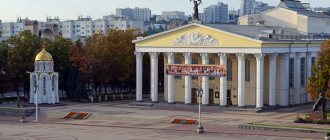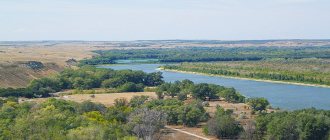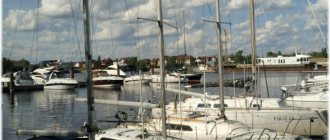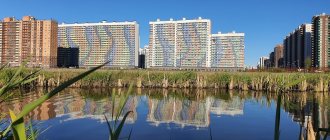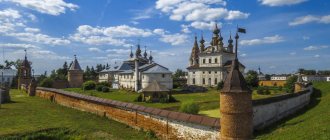Staraya Russa
Staraya Russa is a city of flower shops and funeral homes. Here, under the canopy of weeping willows and chestnut trees, the graceful Polist slowly carries its waters, and local canteens serve Buratino lemonade for six rubles per glass. All this is so wonderful that you immediately want to drink sweet soda, give some beautiful Rushanka a bouquet of flowers, walk with her along a quiet embankment overgrown with trees, and then die with a calm soul. Well, maybe before that you can also smear yourself with healing mud at a local resort, but this is not for everyone.
I came to Staraya Russa for the aeronautics festival, so I didn’t have time for all the above-mentioned entertainment - I only managed to run back and forth through the vegetable gardens a couple of times, avoiding the crowds of tourists, of which there were surprisingly many here.
No, of course, I knew that in Staraya Russa there is one of the oldest balneological and mud resorts in Russia. But I was sure that it had long been forgotten and abandoned by everyone. It turned out that the resort in Staraya Russa is not only not abandoned, but is even thriving. There are a dozen buildings on the territory, several relatively large hotels in the city center, a couple of small guest houses - and there are practically no places anywhere. And I thought it was a quiet province...
The province turned out to be really quiet after all. And although the tourists in the city are like uncut dogs, they all either cluster around the resort area fenced with a high fence, or explore the second main attraction of Staraya Russa - the Dostoevsky house-museum. By the way, both of these places of interest ultimately passed me by.
While I was flying in a hot air balloon, the scout I sent there, Dimon, was studying the resort. As soon as I landed, reconnaissance reported: the task was completed, there was nothing decisive to look beyond the fence. And we went to the Dostoevsky Museum. There, after hanging out in the cramped lobby with a couple of tourist groups, we bought two magnets from the ticket office instead of two tickets to the museum, and, pleased with ourselves, went for a walk around the city.
Here I cannot help but notice that next to the Dostoevsky Museum there is one of the most beautiful places in Staraya Russa - a miraculously preserved old cobblestone street laid along the river. No granite embankment, no parapets, no benches, no pseudo-Dostoevsky lanterns - only cobblestones and old willows bent over the surface of the water. Unfortunately, I didn’t think of photographing this miracle, although I probably should have - I’m afraid in a few years everything might be different there...
In general, Staraya Russa is one of the oldest Russian cities. It is located on the Polist River, at the confluence of the Porusya River (sometimes also called Pererytitsa).
Residents of Staraya Russa are called Rushans.
Despite it being Saturday evening, the city greeted us with silence; there were almost no drunks on the streets.
The balloon festival was in full swing. The balloons, solemnly launched from the central stadium, flew off into the distance, and only a large airship remained in the sky, leisurely floating back and forth over the city center.
In addition to the balneal and mud resort and the Dostoevsky Museum, Staraya Russa is famous for its temples. The most famous of them is the Resurrection Cathedral.
Once upon a time, the history of the city began from this place: there was a fortified fort here on the cape. Well, the first temple appeared here only in the 17th century. It was rebuilt several times, the last time almost two hundred years ago according to the design of the architect Stasov.
The Resurrection Cathedral had a particularly turbulent history in the 20th century - in Soviet times it managed to be a local history museum, which, by the way, has now moved to another cathedral, and a military museum, and a stable, and a club, and a cinema - in general, a rich biography , you can't say anything. Since the early 1990s, the building has again served its religious functions.
I have always been touched by the juxtaposition of recently restored Orthodox churches and Lenin monuments inherited from the USSR: so different - and yet together. Usually such a neighborhood is the first sign that you can find a lot of interesting things in the city.
My experience did not deceive me: Staraya Russa really had something to surprise. What was it worth at least for the episode when Dimon and I, having drunk a fair amount of Abkhaz wine, stood on the terrace of our guest house and enjoyed the Russian rock music coming from some neighboring gardens, performed to the accompaniment of an accordion.
The Resurrection Cathedral is, of course, beautiful. I’ve never been a fan of the pompous Russian Empire style, especially when it appears before me in the form of religious objects, but there’s definitely something in this temple.
By the way, the cathedral was painted in a bright brick-red color quite recently, just a few years ago. Before that, it was yellow for a long time.
You don’t even have to go anywhere to find beauty in Staraya Russa, it’s right in the air. For example, everything that has to do with the city is denoted by the possessive adjective “Old Russian”. Romance!
Starorussky district. Old Russian cheese. Old Russian vandals.
And although the latter do not sleep, in architectural terms Staraya Russa also has something to boast about.
On the central square - Sobornaya - there is an old water tower, built a hundred years ago, just then the first water supply system appeared in the city.
In Soviet times, this square bore the name of the Revolution, and before the revolution - Trade Square: Old Russian, Novgorod, Tver, Suzdal and Moscow merchants have long met here.
We walked leisurely, munching on pies bought at a nearby stall. A drunken woman was sitting on a podium that had appeared out of nowhere in the middle of the square: “Hey, guys, tell me the time?!”
Here, in one of the neighboring buildings, two new contenders for the title of “best window in the world” were unexpectedly found.
In general, from an architectural point of view, Staraya Russa is a post-war city. When it was liberated by Soviet troops in February 1944, there was not a single resident and practically not a single intact building left.
Having been rebuilt almost from scratch in the post-war years, this city somehow miraculously managed to preserve its Soviet, slightly neglected, but amazingly kind atmosphere. I thought that it could only be found in old films. But no - welcome to that Staraya Russa!
Lilacs are fragrant and chestnuts are blooming everywhere.
Chestnuts! Where did you last see blooming chestnuts in St. Petersburg? And in Staraya Russa - please, on every corner!
The buildings are gradually falling into disrepair.
Along with them, in order not to stand out, the old sidewalks, which have not seen repairs since Soviet times, also fall into disrepair.
The city lives its own life.
The walls of old Russian houses are decorated with the most elegant indicators of distances to hatches, drawn by hand. If you look closely, you can see their previous interpretation under the faded paint. I wouldn’t be surprised if there are several more ancient layers hidden underneath it.
Staraya Russa is very green. And very quiet. Even to me, who has been living in the countryside for eight years now, this silence seemed unnatural - it doesn’t get so quiet in cities.
An old wooden bridge leads to the opposite bank of the Polisti. It is located on the site of an ancient crossing. Once upon a time, this bridge was floating and swayed when loaded; because of this feature, the name “Live” was assigned to it. That's what they call him to this day.
After the revolution, the communist machine mercilessly swept through the cities of the USSR, renaming most of the streets, avenues and squares in a new way. The Old Russian communists decided to break away in a special way: when the surnames of party leaders for street names ran out, they turned on their imagination at full capacity, and this is how toponymic masterpieces like the October Events and the Proletarian Victory appeared. However, recently the process has reversed, and some streets have begun to be returned to their historical names.
Among all this communist schizophrenia, Svarog Street stands apart. The owner of the guest house where we lived told a funny story: some time ago, almost a scientific expedition came from Moscow to study the history of the name of this street. Imagine their disappointment when it turned out that the ancient Slavic god had absolutely nothing to do with it, and the street got its name in honor of a local artist who worked under such a pseudonym at the dawn of the USSR.
In the center of the city, between the Soviet four-story buildings and the vegetable gardens of local residents, the Spaso-Preobrazhensky Monastery has stood since the 12th century.
Let's climb the former bell tower. Let's look in one direction.
Then - to another. Let's be sad.
There are several museums located in the former monastery buildings. One of them is an art gallery of the same artist Svarog.
The second is a quite interesting local history museum.
Here you can learn the legend about Rus and Sloven - the epic ancestors of the Russian people. According to legend, in the middle of the 3rd millennium BC, the ancestors of the Slavs left the shores of the Black Sea and reached Lake Ilmen, in the north of which Sloven founded the city of Slovensk (now Veliky Novgorod), and in the south Rus founded the city of Rusa (now Staraya Russa ). In the legend you can find many other interesting episodes: about the Slavs’ campaigns against Egypt, and about negotiations with Alexander the Great, and about the visit of Apostle Andrew to Rus', and about much, much more, right up to Gostomysl’s calling Rurik to reign. In general, a most interesting work, even if it appeared only in the 17th century. Although, in fairness, different variations of this legend were found in various chronicles earlier, starting from the 10th century.
If we talk about more authoritative sources, then Staraya Russa was first mentioned in the middle of the 12th century. AD, of course. At the same time, archaeologists believe that already a hundred years before this, Rusa (that’s what the city was called until the 17th century) was already a developed settlement with wooden pavements and dense urban development.
From the very moment of its foundation, Staraya Russa was under the influence of Novgorod, until in the 15th century the city came under the rule of Moscow. All this time, Staraya Russa was an important center of salt production and trade.
At least twice in its history, the city was ruined almost to the ground - first, in the 17th century, the Swedes frolicked here very well, then in the 20th century - the Germans.
In the local history museum you can see an interesting collection of birch bark letters found on the territory of the city - ancient Russian mail, used until the 15th century.
Here, for example, is birch bark letter No. 10, dating from the 12th century: “This is a letter from Yarila to Onania. In Gorodishche, your domain, there is only water to drink (there is nothing left to eat). And the Rushans (residents of Rusa) mourn for the town residents. If you want, intimidate the nobles so that they don’t do anything dirty!”
But much more interesting is birch bark document No. 35, also from the 12th century.
It consists of two lines. First line: “From Radoslav to Choteslavow. Take ou prasol 2 hryvnia and 5 kouno.” Second line: “Yakov brother, fuck lying down, fuck, fuck.”
Next is a brief interpretation of the letter. Radoslav gives instructions to his brother Hoteslav: “Take 2 hryvnia and 5 kuna from the prasol (merchant).” Hoteslav categorically does not like this instruction: perhaps his brother is sending him to prasol instead of simply paying off his debt. He answers sarcastically and without hesitation in the form of expression. The address “Yakov brother” (and not “Radoslav”) is apparently ironic or even sarcastic: Khoteslav calls his brother not by his secular name, but by his baptismal name, and even with the word brother, which is appropriate only in a church or in a particularly solemn situation, but not in any way combined with the subsequent rudeness of “fuck lying down”. The latter carries the meaning - “Don’t be original, be like everyone else!” To this expression, Hoteslav adds two more intricate epithets for Radoslav-Jakov: “ebehota” - lustful, and the less clear “aesova” - most likely a compound word from “ae” - egg - and “sovati” - to poke.
Well, that's brilliant! There are no words. Nowadays they no longer know how to swear so gracefully.
By the way, this little document refutes the theory that Russian swearing appeared only during the Mongol-Tatar yoke. Fuck you, fuck him lying down!
Well, to conclude my story about Staraya Russa, I can’t help but tell you about the mineral springs. There are eight of them in the city, and all of them were drilled by hand.
The most famous of them is the Muravyovsky fountain, located directly on the territory of the resort. This is the most powerful mineral spring in Europe. Today it looks like an ordinary fountain, although in the old days an elegant pavilion was built above it (image credit).
I visited two lesser-known springs located on the outskirts of the city.
The first of them is Tsaritsynsky, drilled in the middle of the 19th century. It is just a huge rusty pipe sticking out of the ground. By the way, the depth of the well is 246 meters.
The second is Catherine's. It is located about fifty meters from Tsaritsynsky and is significantly inferior to it in power. It is unknown when it was drilled.
That's all for today.
Don't switch!
Continuation: A story about those who do not look for easy ways
Reconstruction of Cathedral Square is underway in Staraya Russa
Archaeologists are also working next to the builders. The renovation is the first opportunity in a long time to look deep into the medieval life of the city center.
The heart of Staraya Russa. Until 1917, it was Trade Square, and after the well-known events - Revolution Square. Here is also one of the city’s calling cards – the water tower. And if the fate of the last attraction is still in question, everything has already been determined with the square. As part of the tourism development program, restoration began here.
Natalya Gorchakova, Chairman of the Committee for Construction and Housing and Public Utilities of the Starorussky District Administration: “We started work at the end of May, removed the layer of asphalt that was required for further work. Trenches with existing sewerage, water supply and storm sewer networks have been opened and these networks are now being rebuilt. This is necessary because wear is 80-90%.”
According to the project, a recreation area is planned around the tower. Trees will be planted here and granite benches will be installed. The public was shocked by the cutting down of the blue spruce trees beloved by the Rushans. Although everything here is within the law. A long time ago, trees were planted right in the area of utility networks, which was impossible to do. Now all communications are being updated, and the vegetation had to be cut down. Although, as administration officials explained, the townspeople are still heard.
Artem Kostin, head of the department of architecture and urban planning of the Starorussky district administration: “During a meeting with the public on January 30, 17, it was decided to make changes to the project and preserve the linden alley. This will be another area where in the summer you can sit in the shade and enjoy the silence, since Lenin Street will now be pedestrianized.”
They plan to hold exhibitions of artists and craftsmen and organize one-man performances in the park. By the way, the central pedestrian streets of the city will also be restored. They will repair the water supply, sewerage, and storm drains. Clinker tiles will be laid on the sidewalk. The square itself will become paved.
This place is empty for now, but soon the main decoration of the square will appear here. The granite fountain in the form of a round thicket will be surrounded by benches and trees symmetrically to the water tower.
In parallel with the builders, archaeologists are working on the square. The discoveries of historians only confirm that in the past, life was in full swing at this place. The earliest period that the discovered artifacts date back to is the fourteenth to fifteenth centuries.
Pavel Kolosnitsyn, researcher at NovSU : “The finds are very diverse. Household items, remains of leather shoes, ceramic dishes, pots, various tools, tools, jewelry, seals. There were several coins, including the Novgorod copper pula.”
Renovating the city center will cost about two hundred and seventy million rubles.
It is planned that the new view will open to the residents of Rushan in December of this year. Add NT to your sources to stay up to date with the news of the day.
Stripped off the sticky
Along with the beautiful Resurrection Cathedral of the late 17th century and the hundred-year-old water tower, these linden alleys were one of the attractions of the central part of Staraya Russa. They were dropped off by soldiers and civilians returning from the front - in a common desire to revive their beloved city from the ruins.
Bricks from the destroyed buildings were then used to restore the school and build dugouts. And in place of the ancient buildings, linden alleys were laid, which became a kind of living monument to the revival of the city.
Meanwhile, ruthless pruning is not the arbitrariness of the builders, but a stage in the implementation of a promising project to create the Starorussky tourist cluster - an event of the federal target program "Development of domestic and inbound tourism in the Russian Federation" (2011-2018), which includes the reconstruction of Cathedral Square and the organization six-kilometer tourist walking route. As part of this project, more than 300 million rubles were invested in the improvement of Staraya Russa in 2021.
The reconstruction of the square began in earnest last year. The original project involved completely uprooting all the trees, thereby almost doubling the size of the area. But the Old Russians insisted on preserving the lindens, emphasizing their importance in the historical memory of the city. and in February last year, at the request of the public, changes were made to the project developed by the creative workshop of the Novgorod architect Valery Perepelitsa.
The head of the Starorussky district, Vasily Bordovsky, did not forget to repeat at every opportunity that the authorities listened to the opinion of the people. Imagine the surprise and indignation of those same people when “horns and legs” remained from the saved linden alleys. People simply did not have time to do anything - they began beheading the lindens when the entire square, right up to the embankment of the Polist River, was behind a high fence of reconstruction builders and access to it was prohibited. Moreover, earlier work was carried out to form the crowns of trees growing on Voskresenskaya Street, which runs parallel to Cathedral Square. The linden trees there have already been crowned - why not give them a beautiful spherical shape again. No one could have imagined that someone would encroach on the shady linden alleys separating Voskresenskaya from the square. Over the course of 70 years, they have grown to almost the size of a five-story building.
But when the fence was removed in mid-January, people saw real stumps in the depths of the construction site. And then the municipal authorities completed the decapitation of four rows of linden alleys in a few days.
— It was decided not to leave such a multi-level “boot” between the renewed square and Voskresenskaya Street (somewhere it was cut off, and somewhere it was overgrown). And we gave the task to level the tree crowns,” explained the head of the Starorussky district, Vasily Bordovsky.
The official is confident that he did not break his promise to preserve the linden alleys, but in fact he pronounced a death sentence on the trees. Only delayed. Work on crown formation is not carried out during winter frosts. As Elena Kiseleva, a practicing specialist in the field of landscaping and landscaping, said, the crown of mature trees, even in favorable weather, can only be shortened by a third. And not overnight, but over two seasons. In our case, God forbid, if one third is left alive.
Rushanka Nelly Aleksandrovna Guseva (she is already 80 years old) cannot look at what is happening without tears:
“The linden trees that the girls and I planted after the war and which we looked after for years are now sentenced to destruction. I don't believe they will survive. You can’t prune them in winter!
You cannot trim, leaving only “pillars”. There will be no more linden alleys in the city center...
Seeing what the would-be lumberjacks had done to the alleys adjacent to the square, the townspeople tried to save at least what had survived. Letters demanding to stop the work were sent to the administration and the prosecutor's office. The head of the district, Bordovsky, under the pressure of public opinion, promised not to cut off the remaining linden alleys. And he even complained that the Uyut specialists seemed to be not even very good specialists; they lacked professionalism. Otherwise, they would have left more branches on the linden trees they were pruning.
The Old Russians no longer believe it and listen with bated breath to see if the sound of a working chainsaw will be heard again over the Polist River in the center of the ancient city.
Direct speech
Elena Evdokimova, Candidate of Biological Sciences:
— At negative air temperatures, the trunks freeze. And the larger the cut, the more dangerous it is for the survival of the trees. No means for processing saw cuts work at sub-zero temperatures, so frost-damaged tissues die. And when temperatures above zero occur in dead plant tissues, a decomposition process occurs due to fungal and bacterial infections. The most likely is infection with spores of tinder wood-destroying fungi, which subsequently leads to damage to the entire plant, even to its death within several years.
Number
239 limes
barbarously circumcised in Staraya Russa.
